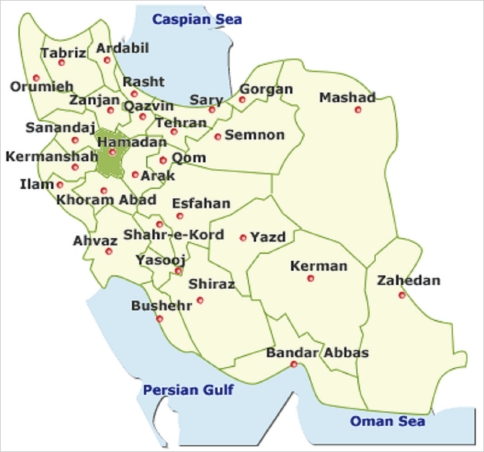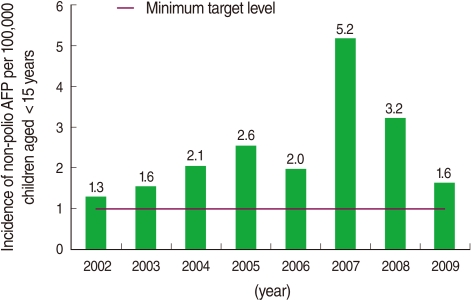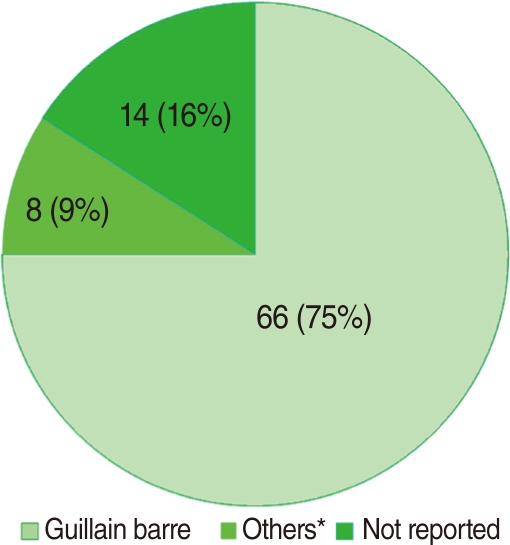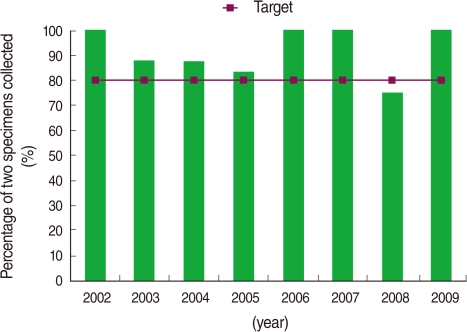Articles
- Page Path
- HOME > Epidemiol Health > Volume 33; 2011 > Article
-
Original Article
Evaluation of Acute Flaccid Paralysis in Hamadan, Iran from 2002 to 2009 - Jalal Poorolajal1, Shadi Ghasemi2, Leila Nezamabadi Farahani2, Atefeh Sadat Hosseini2, Seyyed Jalal Bathaei3, Ali Zahiri3
-
Epidemiol Health 2011;33:e2011011.
DOI: https://doi.org/10.4178/epih/e2011011
Published online: November 16, 2011
1Research Center for Health Sciences, Department of Epidemiology & Biostatistics, School of Public Health, Hamadan University of Medical Sciences, Hamadan, Iran.
2Department of Epidemiology & Biostatistics, School of Public Health, Hamadan University of Medical Sciences, Hamadan, Iran.
3Center for Disease Control & Prevention, Deputy of Health Services, Hamadan University of Medical Sciences, Hamadan, Iran.
- Correspondence: Jalal Poorolajal, MD, MPH, PhD. Research Center for Health Sciences, Department of Epidemiology & Biostatistics, School of Public Health, Hamadan University of Medical Sciences, Shaheed Fahmideh Ave. Hamadan 65157838695, Iran. Tel: +98 811 8380090, Fax: +98 811 8380509, poorolajal@umsha.ac.ir
© 2011, Korean Society of Epidemiology
This is an open-access article distributed under the terms of the Creative Commons Attribution License (http://creativecommons.org/licenses/by/3.0), which permits unrestricted use, distribution, and reproduction in any medium, provided the original work is properly cited.
- 22,573 Views
- 108 Download
- 9 Crossref
Figure & Data
References
Citations

- The Polio Vaccination Status of Non-polio Acute Flaccid Paralysis Cases in the Far North Region of Cameroon: A Five-Year Retrospective Study From 2015 to 2019
Blaise Wakam Nkontchou, Etienne Guenou, Collins Buh Nkum, Celine Mairousgou Tchida, Alphonse Marie Nono, Jerome Ateudjieu
Cureus.2024;[Epub] CrossRef - Assessment of Met and Unmet Care Needs in Older Adults without Mental Disorders Using the Camberwell Assessment of Need for the Elderly: A Systematic Review and Meta-analysis
Parvin Cheraghi, Ahmad Delbari, Zahra Cheraghi, Akram Karimi-Shahanjarini, Nasibeh Zanjari
Journal of Research in Health Sciences.2021; 21(4): e00530. CrossRef - The Acute Flaccid Paralysis (AFP) Surveillance System in Yemen, 2010-2015: Descriptive Study Based on Secondary Data Analysis
Khaled Abdullah Almoayed, Ali Bin Break, Mutahar Al-Qassimi, Ali Assabri, Yousef Khader
JMIR Public Health and Surveillance.2019; 5(4): e14413. CrossRef - Surveillance of poliomyelitis in Northern Italy: Results of acute flaccid paralysis surveillance and environmental surveillance, 2012–2015
Laura Pellegrinelli, Laura Bubba, Valeria Primache, Elena Pariani, Andrea Battistone, Roberto Delogu, Stefano Fiore, Sandro Binda
Human Vaccines & Immunotherapeutics.2017; 13(2): 332. CrossRef - Eradication of Polio in the World; Iran is at Risk for Reemerging of Polio: A Review of the Literature
Seyed Mansour Razavi, Masoud Mardani, Payman Salamati
Archives of Clinical Infectious Diseases.2016;[Epub] CrossRef - An epidemiological analysis of acute flaccid paralysis in Khuzestan Province, southwest Iran, from 2006 to 2010
Ali Akbar Momen, Abdolhussein Shakurnia
Epidemiology and Health.2016; 38: e2016030. CrossRef - Surveillance of acute flaccid paralysis (AFP) in Lombardy, Northern Italy, from 1997 to 2011 in the context of the national AFP surveillance system
Laura Pellegrinelli, Valeria Primache, Lucia Fiore, Concetta Amato, Stefano Fiore, Laura Bubba, Elena Pariani, Antonella Amendola, Maria Barbi, Sandro Binda
Human Vaccines & Immunotherapeutics.2015; 11(1): 277. CrossRef - Clinical and enterovirus findings associated with acute flaccid paralysis in the republic of Korea during the recent decade
HyeJin Kim, Byounghak Kang, Seoyeon Hwang, Sang Won Lee, Doo-Sung Cheon, Kisang Kim, Yong-Seok Jeong, Ji-Yeon Hyeon
Journal of Medical Virology.2014; 86(9): 1584. CrossRef - Characteristics of Acute Flaccid Paralysis Reported by the Surveillance System and Verified by WHO Officer in Akwa Ibom State-Nigeria, 2006-2012
Bassey Enya Bassey, Vaz Gama Rui, Alex Ntale Gasasira, Mkanda Pascal, Goitom Weldegbriel, Ticha Johnson Mulum, Sylvester T. Maleghemi, Emem Abasi Bassey
Health.2014; 06(19): 2602. CrossRef




Figure 1
Figure 2
Figure 3
Figure 4
| Year | Male |
Female |
Both |
|||||||||
|---|---|---|---|---|---|---|---|---|---|---|---|---|
| <5 | 5-9 | 10-14 | Total | <5 | 5-9 | 10-14 | Total | <5 | 5-9 | 10-14 | Total | |
| 2002 | 3 | 1 | 0 | 4 | 1 | 0 | 2 | 3 | 4 | 1 | 2 | 7 |
| 2003 | 3 | 1 | 1 | 5 | 0 | 1 | 2 | 3 | 3 | 2 | 3 | 8 |
| 2004 | 3 | 1 | 2 | 6 | 2 | 0 | 2 | 4 | 5 | 1 | 4 | 10 |
| 2005 | 3 | 2 | 2 | 7 | 0 | 4 | 1 | 5 | 3 | 6 | 3 | 12 |
| 2006 | 1 | 1 | 2 | 4 | 3 | 1 | 1 | 5 | 4 | 2 | 3 | 9 |
| 2007 | 5 | 4 | 2 | 11 | 4 | 2 | 4 | 10 | 9 | 6 | 6 | 21 |
| 2008 | 5 | 2 | 2 | 9 | 1 | 1 | 3 | 5 | 6 | 3 | 5 | 14 |
| 2009 | 0 | 1 | 2 | 3 | 1 | 0 | 3 | 4 | 1 | 1 | 5 | 7 |
| Total | 23 | 13 | 13 | 49 | 12 | 9 | 18 | 39 | 35 | 22 | 31 | 88 |
| Variable | Population | Non-polio AFP | Mean annual incidence rate per 100,000* | Relative risk | 95% CI | p-value |
|---|---|---|---|---|---|---|
| Age (yr) | ||||||
| <5 | 986,426 | 35 | 3.55 | 1.00 | - | - |
| 5-9 | 1,120,311 | 22 | 1.96 | 0.55 | 0.32, 0.94 | 0.030 |
| 10-14 | 1,618,607 | 31 | 1.92 | 0.54 | 0.33, 0.88 | 0.012 |
| Sex | ||||||
| Female | 1,813,246 | 39 | 2.15 | 1.00 | - | - |
| Male | 1,912,098 | 49 | 2.56 | 1.19 | 0.78, 1.81 | 0.414 |
CI, confidence interval. *In order to estimate the mean annual incidence rate of non-polio AFP per 100,000 population aged <15 years old, the cases of each age group were considered as the nominator and the relevant population as the denominator.

 KSE
KSE




 PubReader
PubReader ePub Link
ePub Link Cite
Cite

